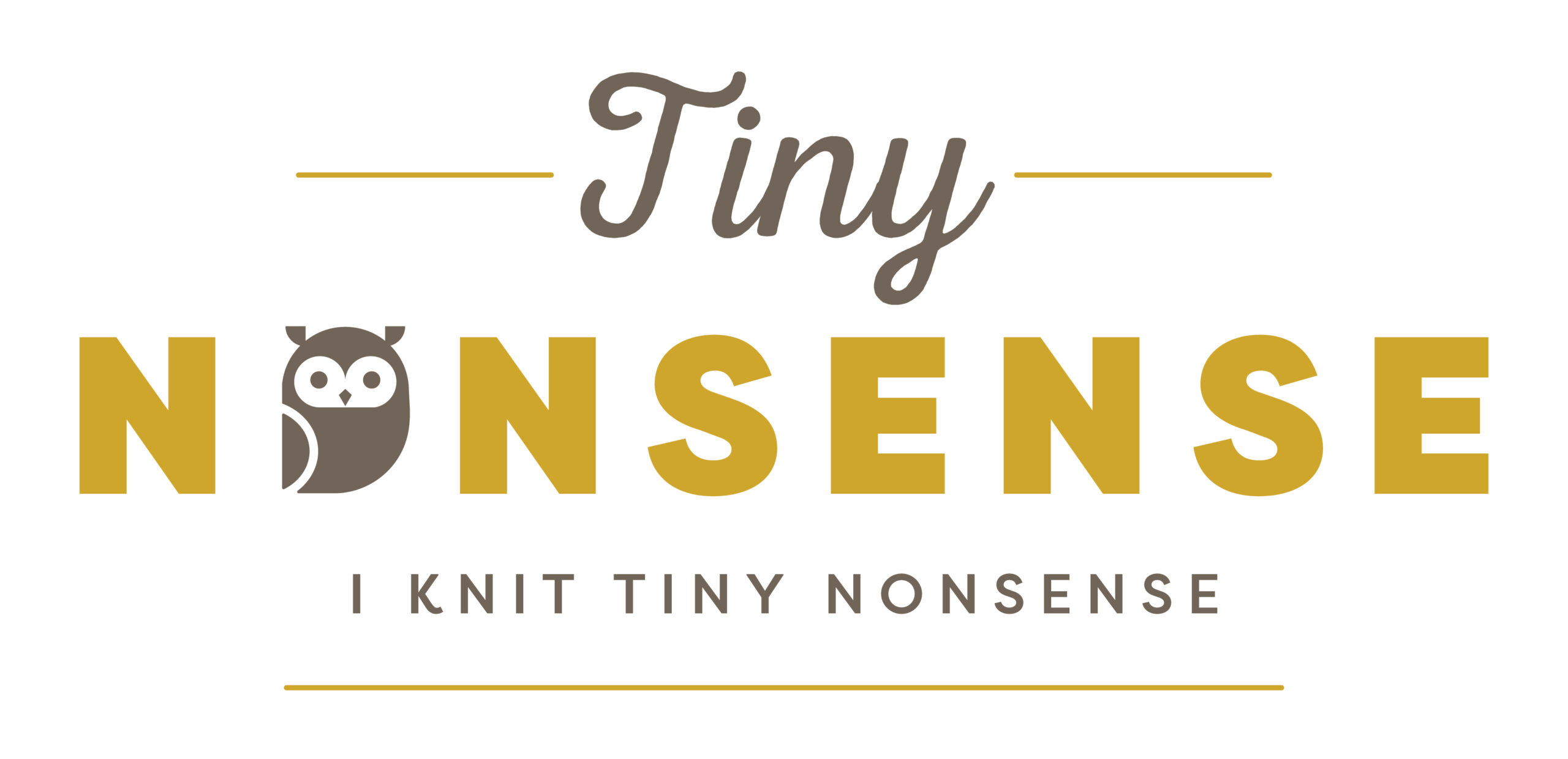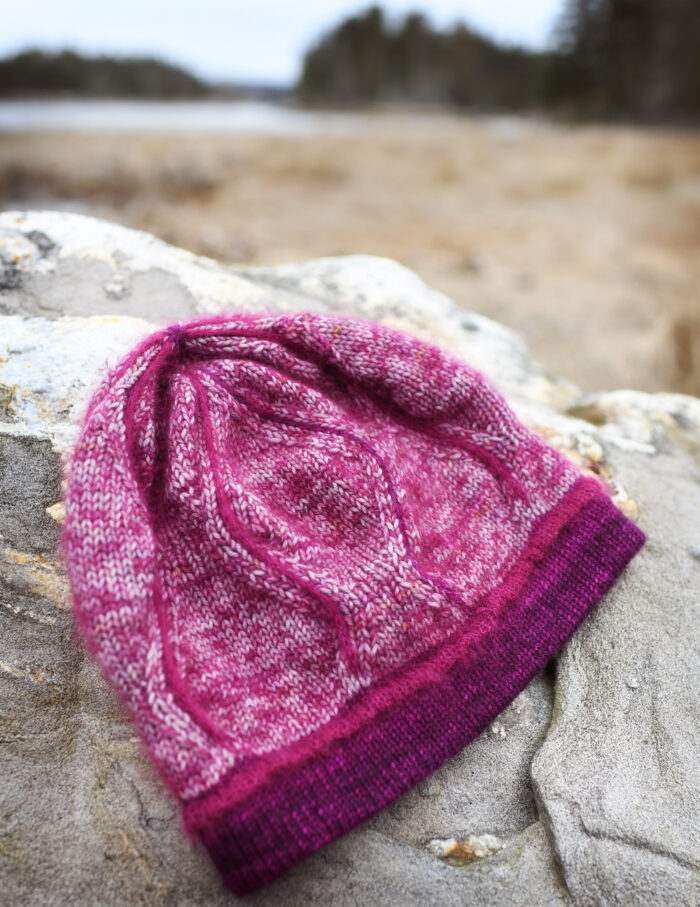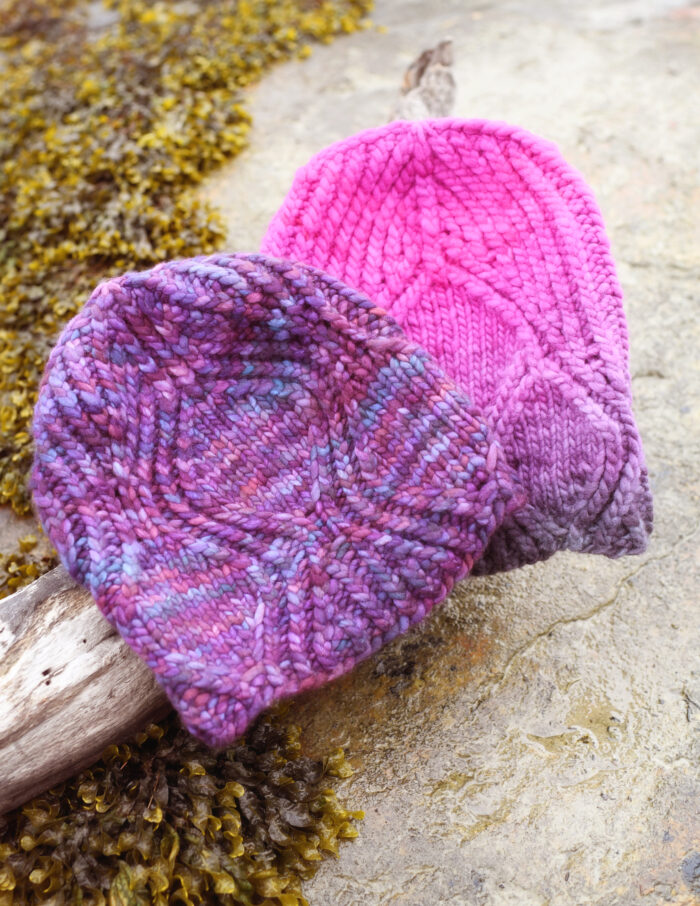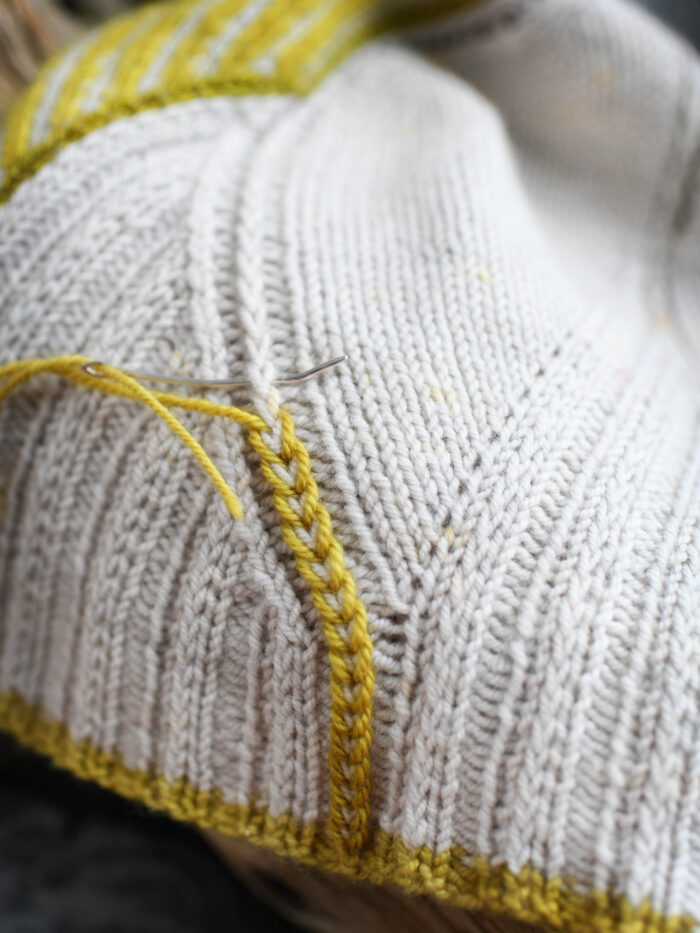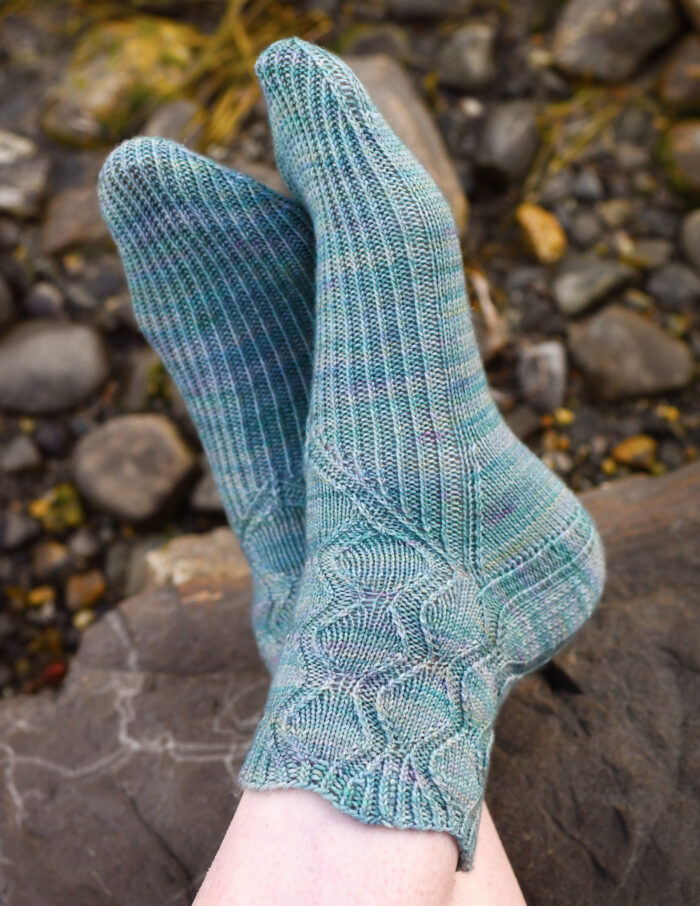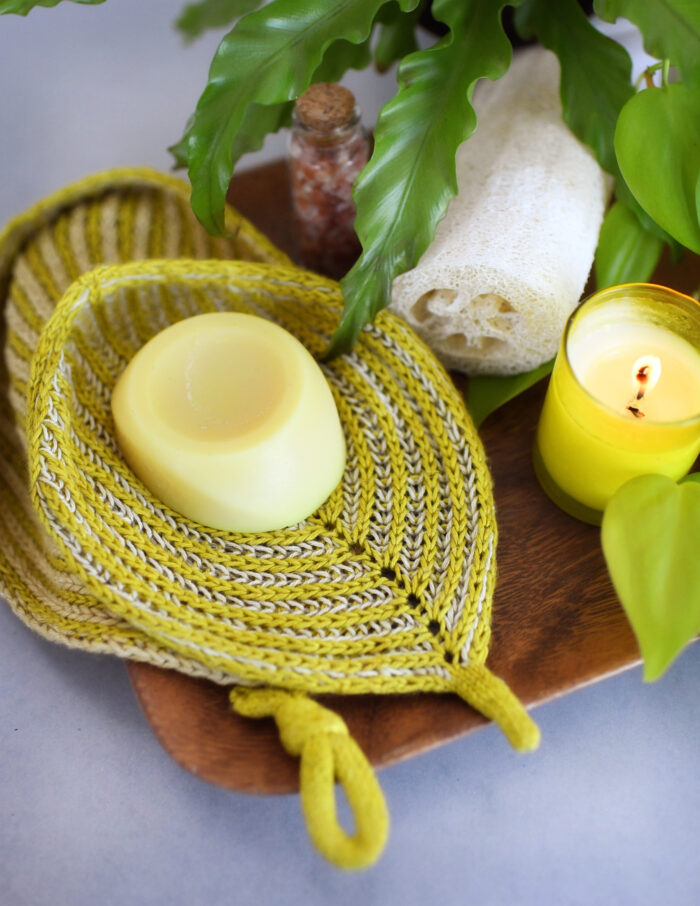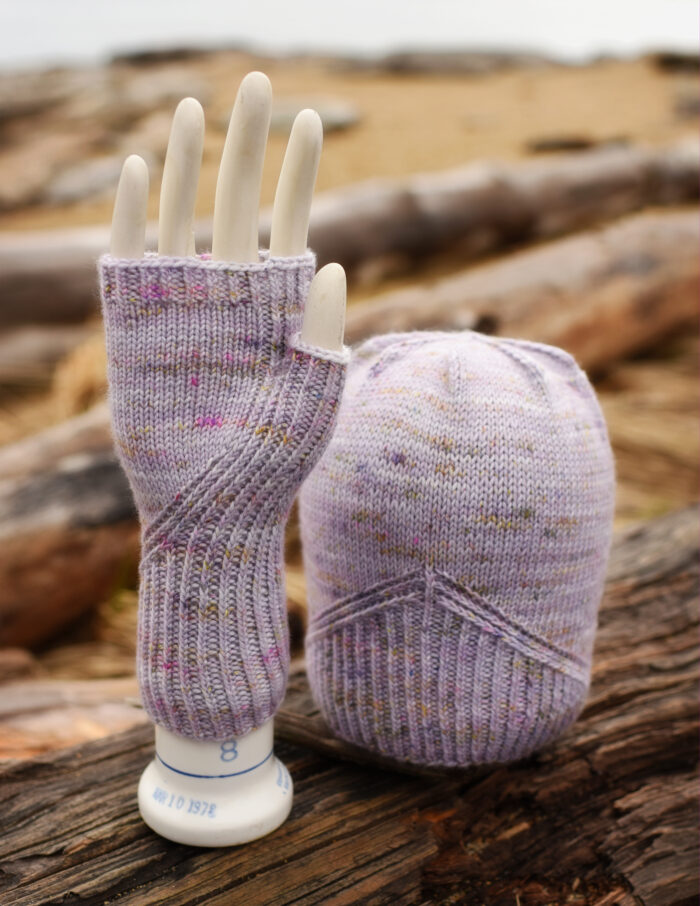Standards
Every now and then, someone writes to me and says something along the lines of “why don’t you use the standard chart symbols?” More often, I’ll see someone say on ravelry some variation of “gee, I like her patterns, but I wish she’d use standard chart symbols.” The only thing I can think in response is what standard chart symbols?
There is really no such thing. Not even a little.
In fact, chart symbols (and charts in general) are staggeringly different from one book to the next. I pulled a handful of books off my shelf, they all use different conventions. The differences are a bit amazing. They don’t agree on what symbols to use for various stitches. They don’t agree on whether to show wrong side rows. If they do show wrong side rows, they don’t agree on how to depict them (as they’re seen from the right side of the fabric, or as you’d work them when the wrong side of the fabric is facing you). They don’t agree on how to depict maneuvers that involve more than one stitch. There’s really not much they do agree on.
They’re different enough that I want to actually show you a few examples, just to demonstrate how dramatically things change from one book to the next. We’ll start with the basics, plain old knits and purls.
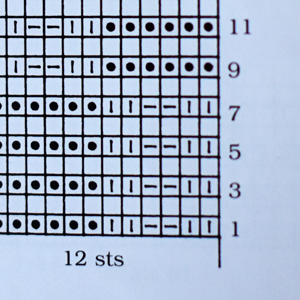 That’s a knit/purl only pattern from Big Book of Knitting Stitch Patterns. Knit is a vertical line, purl is a horizontal line, the dots are ‘garter’, and the blank squares are ‘work as set.’ So there you’ve got four symbols to represent two stitches.
That’s a knit/purl only pattern from Big Book of Knitting Stitch Patterns. Knit is a vertical line, purl is a horizontal line, the dots are ‘garter’, and the blank squares are ‘work as set.’ So there you’ve got four symbols to represent two stitches.
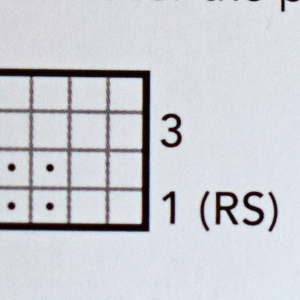 This is from The Knit Stitch Pattern Handbook. Here, knits are blank squares and purls are dots.
This is from The Knit Stitch Pattern Handbook. Here, knits are blank squares and purls are dots.
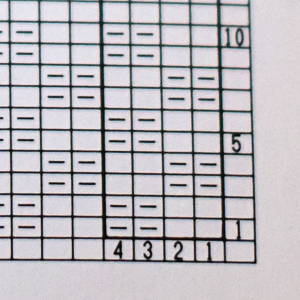 One more, this time from 1000 Knitting Patterns Book. Here we’ve got the knits as blank squares and the purls as horizontal lines.
One more, this time from 1000 Knitting Patterns Book. Here we’ve got the knits as blank squares and the purls as horizontal lines.
So, not a lot of similarities, even in the most basic stitch patterns. What happens if we look at decreases?
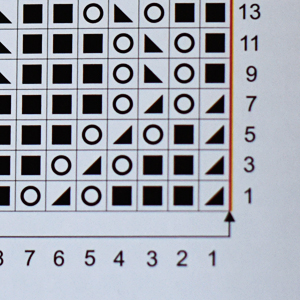 This shows basic decreases in The Haapaslu Shawl. Solid triangles lean whichever way your decrease goes (also for those keeping track at home we’ve got yet another way to represent knit stitches now, solid squares).
This shows basic decreases in The Haapaslu Shawl. Solid triangles lean whichever way your decrease goes (also for those keeping track at home we’ve got yet another way to represent knit stitches now, solid squares).
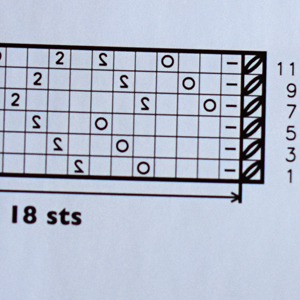 This book, Beautiful Knitting Patterns, uses a totally different method. Here the number 2 is used (either the expected way or reversed) to represent basic decreases. On other charts in this book, 3 is used the same way to represent double decreases.
This book, Beautiful Knitting Patterns, uses a totally different method. Here the number 2 is used (either the expected way or reversed) to represent basic decreases. On other charts in this book, 3 is used the same way to represent double decreases.
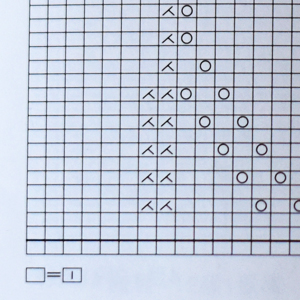 This chart, from Knitting Patterns Book 300, may look a little more familiar.
This chart, from Knitting Patterns Book 300, may look a little more familiar.
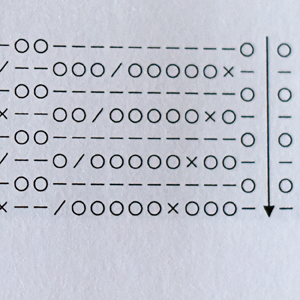 But let’s not forget Omas Strickgeheimnisse. Deep breath. Knits are circles (a whole new way to represent knits). Purls are horizontal lines. Yarn overs are (somewhat surprisingly) slashes. Right-leaning decreases are Xs.
But let’s not forget Omas Strickgeheimnisse. Deep breath. Knits are circles (a whole new way to represent knits). Purls are horizontal lines. Yarn overs are (somewhat surprisingly) slashes. Right-leaning decreases are Xs.
Ok, so there doesn’t seem to be a unified way to show decreases either. What about something a bit more specialized, how do one over one twisted cables look in different places?
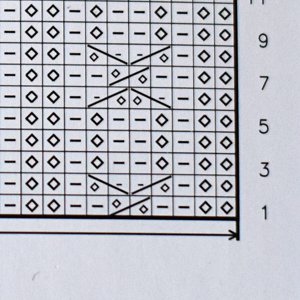 This is again from Beautiful Knitting Patterns. The diamonds are twisted stitches and the long diagonal lines show how the cables cross.
This is again from Beautiful Knitting Patterns. The diamonds are twisted stitches and the long diagonal lines show how the cables cross.
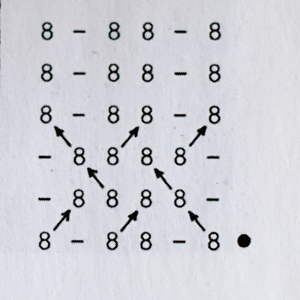 Twisted-Stitch Knitting follows a totally different convention. Twisted stitches are shown as 8s and the arrows tell you how to move stitches from one row to the next.
Twisted-Stitch Knitting follows a totally different convention. Twisted stitches are shown as 8s and the arrows tell you how to move stitches from one row to the next.
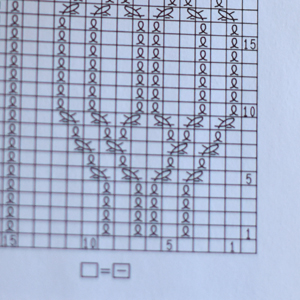 There’s yet another method used in Aran Knit Patterns 100. Here the twist stitch symbol and the cable direction indicator combine into one symbol. Oh and note the little symbol at the bottom saying that in this chart, blank squares are purls.
There’s yet another method used in Aran Knit Patterns 100. Here the twist stitch symbol and the cable direction indicator combine into one symbol. Oh and note the little symbol at the bottom saying that in this chart, blank squares are purls.
I know that was a giant wall of pictures (and thank you for sticking with me if you’ve made it this far). But I hope it shows that there really isn’t any such thing as standard anything. Pretty much everything varies tremendously from book to book (and even sometimes within books).
What people often mean when they ask for some non-existent set of standard symbols is “the symbols I’m used to.” If a knitter has primarily used only one designer or one company’s patterns, it’s really easy for them to assume that the symbols they’ve seen there are the right ones and anything else is wrong (or at least non-standard). But if you work from a wide variety of patterns, you’ll see that there really is more than one way to present the same set of information.
This becomes even more important when patterns use a wide variety of stitches (which mine tend to do) or unusual stitches (I like to do that too). I don’t think there is any symbol I could use that would instantly convey to everyone ‘right-leaning, twisted double decrease.’ But sometimes, that’s really the stitch you need! That’s why there is a key (and instructions) right there telling you exactly what the symbol means and how to do the stitch. I promise everything you need is there!
And I do try very hard to keep my symbols and explanations consistent across my own books and patterns (one of the many advantages of publishing my own work). But I fear there is never going to be any such thing as a set of standard chart conventions, no matter how convenient such a thing would be.
A note about the images: I used photos of small portions of the charts from a variety of the stitch dictionaries I own (and listed where each one came from). None of the pictures show the whole chart, and none of them show the what sort of fabric these stitches would make. Given the very small part of the original works shown (portions of single charts from books that contain hundreds of charts) and the nature of the post (hopefully educational!), I feel like this qualifies as fair use. Of course if you are or represent the copyright holder of any of these works and you want me to take it down, just get in touch and I will.
Mailing List
Want to hear when a new pattern comes out or something fun is going on? Sign up below!
Patreon
Want to support the content I create, get nifty bonus material for some of my favorite patterns, or get every new release delivered right to your inbox? Head over to patreon and sign up!
